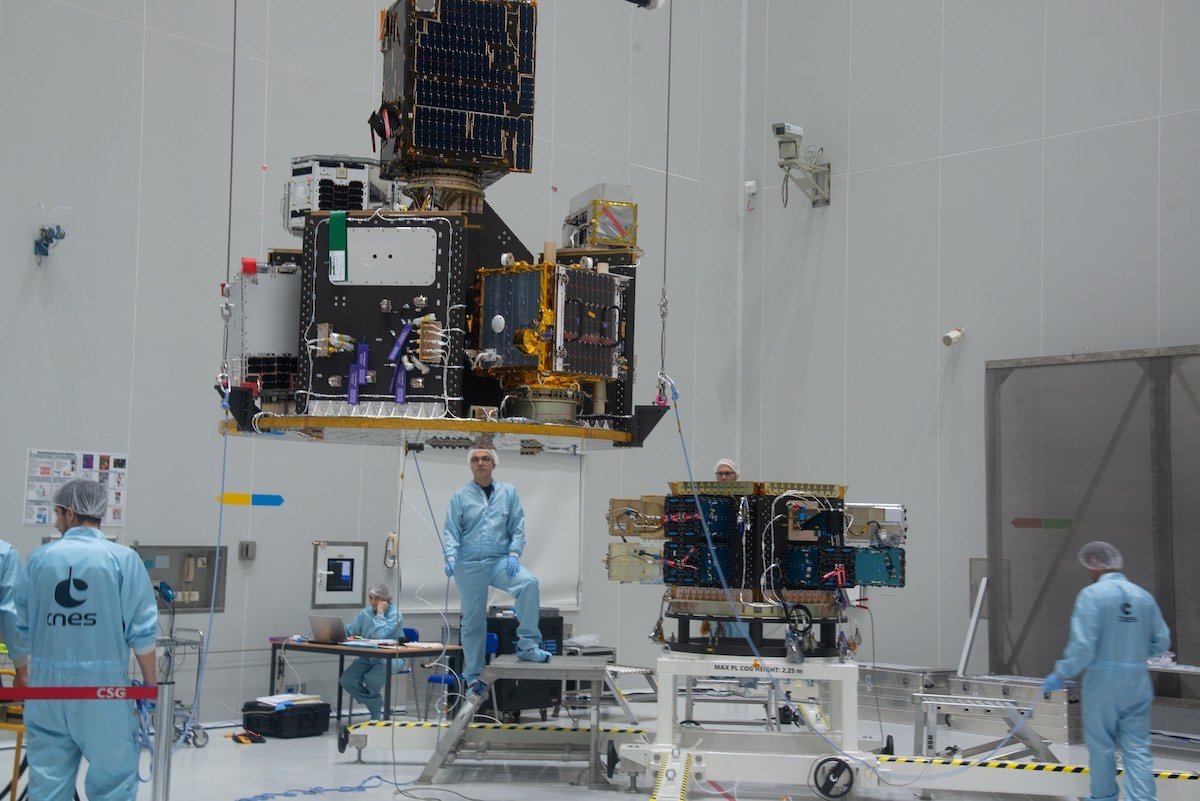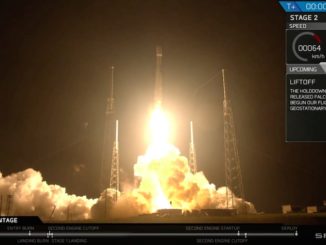
After an unusual stretch of excessive high-altitude winds prevented launch from French Guiana of 53 small satellites on a Vega rocket in June — and no sign of a letup in winds in the coming days — Arianespace said Wednesday that the mission will be delayed to Aug. 17 to allow time for teams to recharge launcher and payload batteries.
The delay to mid-August will also allow Arianespace to move forward with a launch of the company’s heavy-lift Ariane 5 rocket July 28 with a pair of communications satellites for Intelsat and the Japanese operator B-SAT. The Ariane 5 will also carry Northrop Grumman’s second robotic satellite servicing vehicle, designated MEV 2, to dock with an aging Intelsat satellite and extend its life in geostationary orbit.
In a statement Wednesday, Arianespace said forecasters expected no improvement in the upper level wind conditions in the coming days. The high-altitude winds have kept the 98-foot-tall (30-meter) Italian-made Vega rocket on the ground since the mission’s first launch opportunity June 18.
The series of delays has been caused by unusually persistent high-altitude winds, which launch teams assess before all satellite launches. Weather balloons sent aloft by teams in at the European-run spaceport in Kourou, French Guiana, measure high-altitude winds to determine if they are acceptable for launch.
Kourou’s location at 5 degrees north latitude on the northeastern coast of South America puts the Guiana Space Center within a band of trade winds that help drive the Intertropical Convergence Zone. The prevailing high-altitude winds can be problematic for rocket launches that head north from the spaceport, and the winds are typically of highest concern from mid-June to mid-August, sources told Spaceflight Now.
The Vega rocket’s rideshare mission with 53 satellites on-board will launch on a northerly track to place its payloads into two distinct polar sun-synchronous orbits more than 300 miles (500 kilometers) above Earth. The launch is the first flight of Vega’s European-developed Small Spacecraft Mission Service, or SSMS, multi-payload adapter structure, which can support the launch of dozens of small satellites on a single rocket.
Upper level wind concerns have regularly forced launch delays in French Guiana, but the wind pattern this summer is unusually persistent, with forecasters expecting little change in the coming days.
Without a possibility to launch the Vega rocket soon, mission managers decided to recharge batteries on the launch vehicle and the satellites that have been encapsulated inside the rocket’s payload shroud since June 9.
That will require teams at the Guiana Space Center to remove the payload fairing from the Vega rocket on its launch pad. The shroud containing the 53 small satellites will be returned to a processing facility a few miles away, where workers will open the fairing to begin servicing the spacecraft batteries.
The recharging work is expected to take at least several weeks, and Arianespace said Wednesday it would keep its next Ariane 5 launch on schedule for liftoff July 28. The spaceport’s infrastructure can accommodate launches on a cadence of about one mission every two weeks, so the next opportunity to launch the Vega rocket — which uses a launch pad about a half-mile (1 kilometer) from the Ariane 5 pad — would come in mid-August.
The Ariane 5 launch July 28 will head toward the east from French Guiana, and is not affected by the high-altitude wind conditions currently over the spaceport, Arianespace said.
The Vega launch time Aug. 17 is set for 9:51 p.m. EDT (10:51 p.m. French Guiana time; 0151 GMT on Aug. 18).
“Without a foreseeable improvement in the meteorological situation to allow an authorization of the northward launch toward polar orbit in accordance with range safety rules, Arianespace decided to reschedule the next SSMS mission launch attempt for August 17,” Arianespace said in a statement. “At this date, the wind forecasts – based on models observed during several years – are more favorable.”

The first SSMS rideshare mission is a proof of concept demonstration of the adapter’s capability. The 53 satellites on-board come from 21 customers in 13 countries, primarily the United States, European nation and Canada. The launch will mark the 16th flight of a Vega rocket, and the first since an in-flight Vega launch failure in July 2019 that destroyed a military surveillance satellite for the United Arab Emirates.
The launch was originally scheduled for September 2019 before the Vega failure last year. After engineers investigated the accident and introduced corrective actions, the SSMS proof of concept flight was rescheduled for March.
But the coronavirus pandemic forced Arianespace to halt launch operations in French Guiana. After developing new procedures to maintain physical distancing, workers resumed work at the space center in May in preparation for a new Vega launch date of June 18.
“We understand the impatience of our 21 customers, and we share it,” said Stéphane Israël, Arianespace’s CEO, in a statement. “We will now devote all our energy to ensuring the success of the 16th Vega flight for this emblematic mission as quickly as possible.”
The French launch services provider said it expects to launch three Vega rocket missions this year.
A Vega launch previously scheduled for late August with the Spanish SEOSat-Ingenio Earth-imaging satellite and the French Taranis spacecraft to study the link between space weather and electrical discharges from thunderstorms. That launch will now be delayed to later this year.
Another Vega launch is planned around the end of 2020.
Email the author.
Follow Stephen Clark on Twitter: @StephenClark1.



